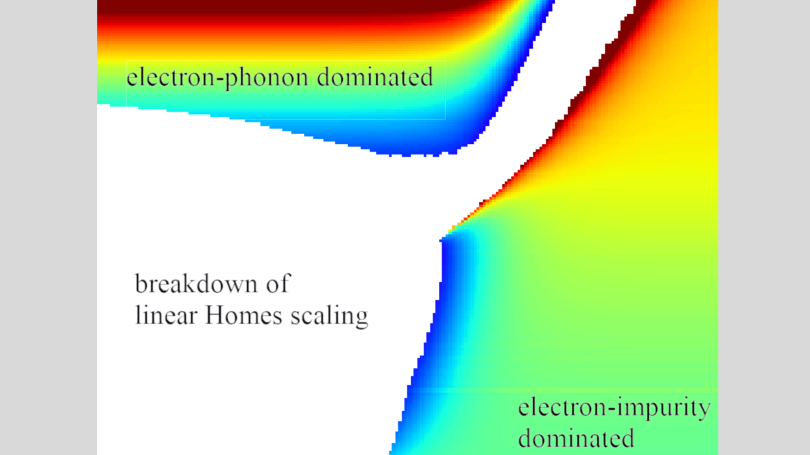

Dartmouth physics professor Rufus Boyack and postdoctoral research associate Joshuah T. Heath have published a new groundbreaking result in condensed matter physics, entitled "Universal Scaling Laws in Electron-Phonon Superconductors", in the journal Physical Review Letters.
Linear scaling relations between fundamental quantities often arise as a system becomes more complex. These scaling laws appear everywhere in our day-to-day lives, and can be seen in phase transitions between different states of matter, in connections between users in social networks, and in the mathematical structure of chaotic systems. Such scaling laws are often universal in the sense that they are independent of the individual system's underlying microscopic details. As a result, these laws capture key concepts that do not depend on a given model.
This past year, Dartmouth physics professor Dr. Rufus Boyack and his postdoc Dr. Joshuah T. Heath developed the first theoretical framework explaining a decades-old scaling law in materials known as superconductors. Their new theory not only explains the underlying basis for such a scaling law, but also establishes its broader relevance and deeper fundamental significance. Heath and Boyack's work has been published in the latest issue of Physical Review Letters.
In 2004, scientists at Brookhaven National Laboratory led by Dr. Christopher Homes found that a linear scaling relationship is obeyed in a class of materials known as high-temperature superconductors. Superconductors are materials that simultaneously have zero electrical resistance and expel magnetic fields upon being cooled to a certain critical temperature, Tc. In conventional superconductors like aluminum and tin, Tc is significantly below room temperature. However, high-temperature superconductors (such as copper-oxide or "cuprate" materials) are exceedingly more complicated and can exhibit superconductivity at significantly higher temperatures.
One of the challenges in the field of high-Tc superconductivity is to identify universal properties that connect all of these materials. A significant breakthrough towards this goal was made by Homes and his collaborators, who showed that the cuprates exhibit a linear scaling relationship between the zero-temperature density of superconducting electrons (the superfluid density) and the product of Tc with the electrical conductivity just above Tc. This relationship is now known as "Homes scaling", and it was soon found to be a nearly universal law for high-temperature superconductors. Surprisingly, Homes scaling was also found to work for conventional (i.e., weakly coupled) superconductors.

Despite the initial success of Homes scaling, a comprehensive theoretical explanation for this relationship was absent. Now, more than 20 years after the work of Dr. Christopher Homes, a new study by Dartmouth-College physicists suggests that Homes scaling is more universal than originally thought. Using a combination of theoretical and numerical methods, Heath and Boyack have given the first general explanation of Homes scaling beyond weakly coupled superconductors. Heath and Boyack used the framework of Eliashberg theory to show that Homes scaling can arise by virtue of strong interactions between electrons and phonons (the latter being a quantum of energy associated with a vibration in a crystal lattice). In this way, the origin of Homes scaling is deeply rooted in the general breakdown of Galilean invariance in the superconducting compound. Such a breakdown may be achieved by two means: either by virtue of electrons scattering off impurities, or electrons scattering off phonons.
Taking their work a step further, the two Dartmouth physicists showed that other scaling laws may emerge by virtue of strong electron-phonon coupling. Upon asymptotically increasing the strength of this coupling, they found that the slope of the Homes scaling relation approaches a universal value for high impurity scattering rates, regardless of the underlying phonon model. Homes scaling is therefore found to be a nearly universal, intrinsic connection between the zero-temperature ground state of a superconductor and the normal state. Moreover, Heath and Boyack showed that Homes scaling is applicable beyond the weak-coupling limit and without the overarching necessity of incorporating high-temperature superconducting physics.
This work paves the way for new research into scaling laws originating from other strong-coupling pairing mechanisms. You can read Heath and Boyack's full publication here.